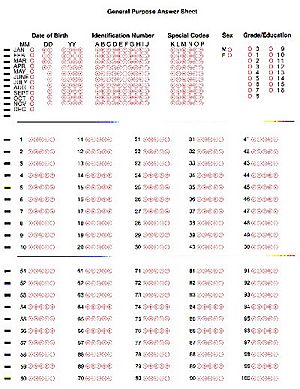Optical mark recognition facts for kids
OMR stands for Optical Mark Recognition. It's a clever way for computers to read marks made on paper forms. Imagine filling out a multiple-choice test or a survey. You make marks with a pencil or pen in specific boxes. OMR technology can quickly and accurately "see" and understand these marks, turning them into information a computer can use.
Contents
How OMR Works
OMR systems use special scanners, much like the ones that scan documents. These scanners shine a light on the paper form. When the light hits a mark (like a filled-in circle), it reflects differently than when it hits an empty space. The scanner detects these differences and sends the information to a computer. The computer then knows which boxes were marked and can process the data very quickly.
Where Do We See OMR?
OMR is used in many places where lots of forms need to be processed fast.
- School Tests: This is one of the most common uses! When you take a multiple-choice test, your answers are often marked on an OMR sheet. This helps teachers grade hundreds of tests in minutes.
- Surveys: Companies use OMR forms to collect opinions from many people for market research.
- Attendance: Some schools or workplaces use OMR sheets to quickly record who is present.
- Lottery Tickets: The forms you fill out to pick your lottery numbers often use OMR.
- Time Sheets: In some factories, workers might mark their hours on OMR forms.
Why is OMR Useful?
OMR offers several great benefits:
- Speed: It can process thousands of forms much faster than a person could. This saves a lot of time, especially for large schools or businesses.
- Accuracy: OMR systems are very good at reading marks correctly, reducing human errors in data entry.
- Easy to Use: Filling out an OMR form is simple, and the machines are easy to operate.
- Cost-Effective: Once set up, OMR can be cheaper than hiring many people to manually enter data.
What Are the Challenges of OMR?
Even though OMR is very useful, it has some challenges:
- Precise Marking: Marks need to be placed accurately within the designated areas. If a mark is too light, too messy, or outside the box, the scanner might not read it correctly.
- False Readings: Sometimes, smudges or stray marks can be mistaken for actual answers, leading to errors. This can slow down the process if forms need to be re-checked.
- Special Forms: OMR often requires specially printed forms, which can add to the cost.
Images for kids
See also
 In Spanish: Reconocimiento óptico de marcas para niños
In Spanish: Reconocimiento óptico de marcas para niños





